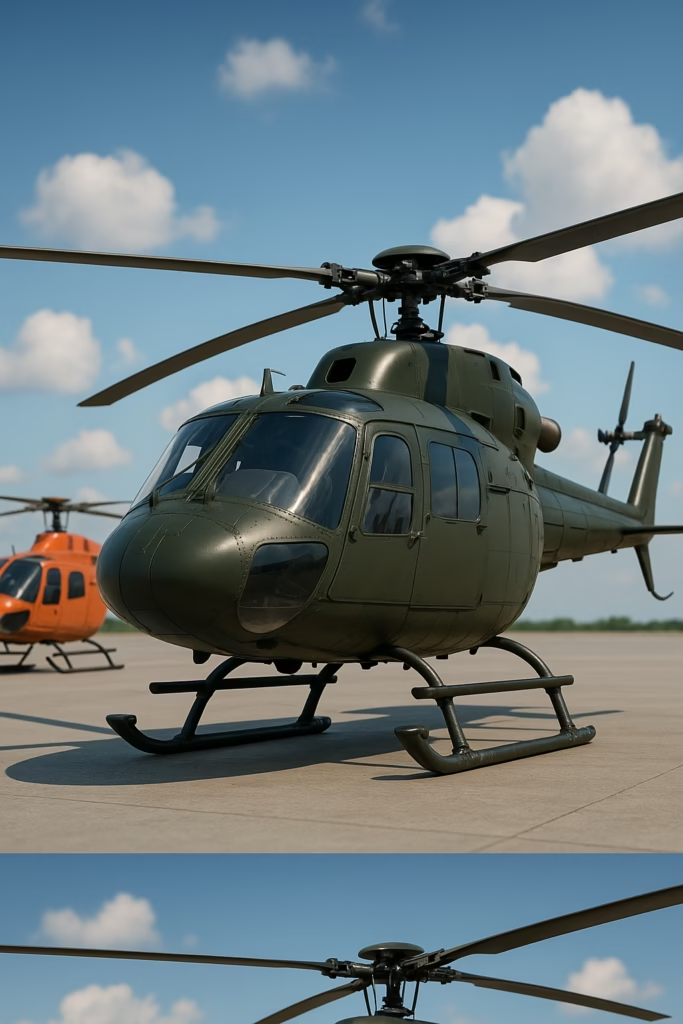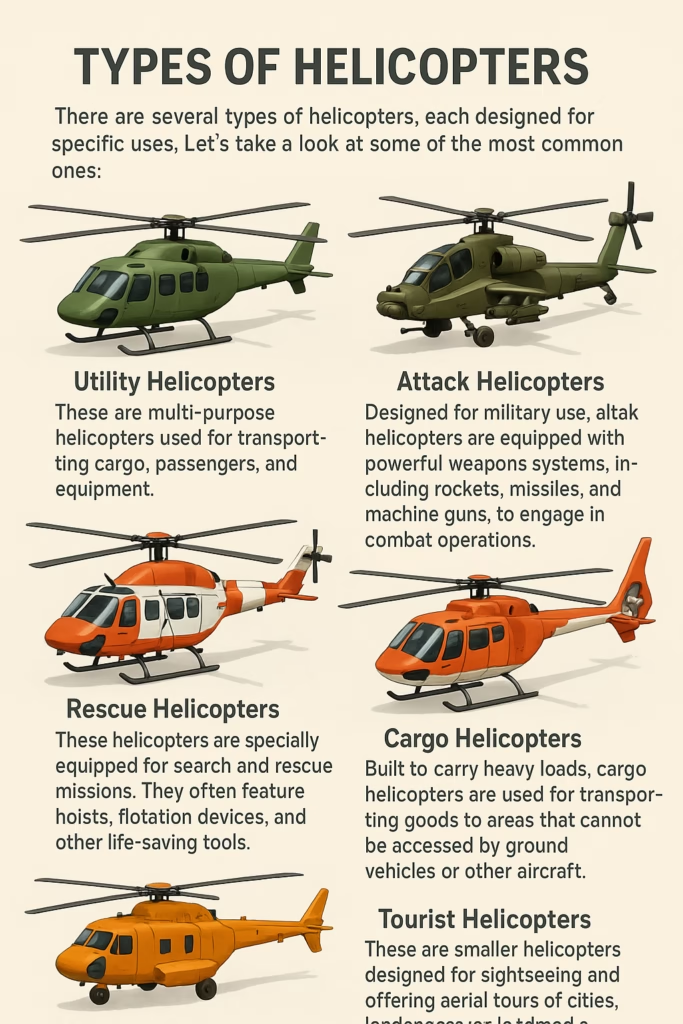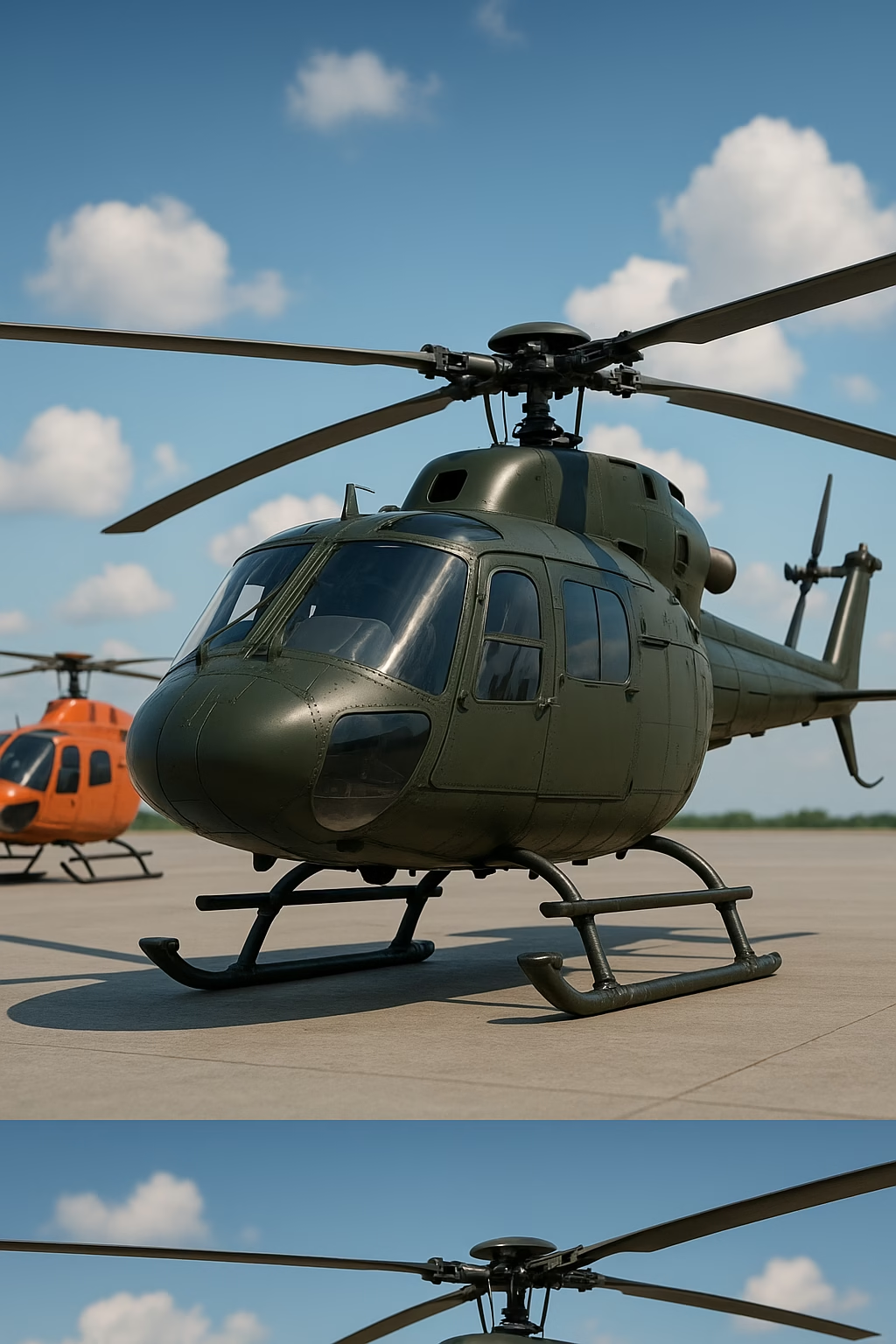The Ultimate Guide to Helicopters: History, Types, Uses, and Future Trends
Helicopters are one of the most versatile and fascinating machines in aviation. Unlike fixed-wing aircraft, helicopters have the ability to hover, take off, and land vertically, making them ideal for a wide range of applications. From military operations to emergency medical services, helicopters are used in various industries around the world.
1. Introduction to Helicopters
A helicopter, also known as a rotorcraft, is an aircraft that uses one or more horizontal rotors to generate lift. The primary difference between a helicopter and a traditional airplane is its ability to take off and land vertically. Helicopters have a wide range of applications, from military operations to search-and-rescue missions and commercial transportation.

The flexibility and unique flight capabilities of helicopters make them indispensable for tasks that other aircraft cannot perform, such as accessing remote areas, hovering over specific points, or rescuing people in difficult-to-reach locations.
2. History of Helicopters
The concept of vertical flight has been around for centuries. Early pioneers, such as Leonardo da Vinci, sketched designs for flying machines that were more conceptual than functional. However, it wasn’t until the early 20th century that actual prototypes for helicopters began to take shape.
The first successful helicopter flight is credited to Igor Sikorsky, a Russian-American aviation pioneer. In 1939, Sikorsky achieved the first sustained, controlled helicopter flight with the Vought-Sikorsky VS-300. Sikorsky’s design became the foundation for future helicopter development.
The 1950s and 1960s saw a surge in helicopter technology, driven by military needs during World War II and the Korean War. These developments transformed helicopters into essential tools for both military and civilian use.
3. Types of Helicopters
There are several types of helicopters, each designed for specific uses. Let’s take a look at some of the most common ones:

Utility Helicopters: These are multi-purpose helicopters used for transporting cargo, passengers, and equipment. They are often used by militaries and commercial services.
Attack Helicopters: Designed for military use, attack helicopters are equipped with powerful weapons systems, including rockets, missiles, and machine guns, to engage in combat operations.
Rescue Helicopters: These helicopters are specially equipped for search and rescue missions. They often feature hoists, flotation devices, and other life-saving tools.
Cargo Helicopters: Built to carry heavy loads, cargo helicopters are used for transporting goods to areas that cannot be accessed by ground vehicles or other aircraft.
Tourist Helicopters: These are smaller helicopters designed for sightseeing and offering aerial tours of cities, landscapes, or landmarks.

4. How Helicopters Work
Helicopters achieve flight through the rotation of their main rotor blades, which generate lift. Unlike airplanes, helicopters can change the direction of their rotors to allow for vertical takeoff and landing, hovering, and more precise control during flight.
The basic principle of helicopter flight involves:
Lift: The rotor blades generate lift by spinning through the air. The angle of the blades (called the collective pitch) determines how much lift is produced.
Thrust: To move forward or backward, the pilot adjusts the angle of the rotor blades. By increasing the forward tilt of the blades, the helicopter moves in the desired direction.
Control: Helicopters use three primary controls:
The collective pitch control adjusts the angle of the rotor blades collectively, increasing or decreasing lift.
The cyclic control tilts the rotor blades to control the helicopter’s movement in any direction.
The anti-torque pedals control the tail rotor, preventing the helicopter from spinning uncontrollably in the opposite direction of the main rotor.
5. Uses of Helicopters
Helicopters are used in a wide range of applications due to their unique capabilities. Here are some of the most notable uses:
Emergency Medical Services (EMS): Helicopters are commonly used to transport patients in critical conditions, especially when ground transportation is too slow or inaccessible.
Search and Rescue (SAR): Helicopters are often called upon to rescue individuals in difficult-to-reach locations, such as mountains, oceans, or forests.
Military Operations: The military uses helicopters for combat, reconnaissance, troop transport, and even medical evacuation.
Firefighting: Helicopters equipped with water tanks or fire retardants are used to combat wildfires in hard-to-reach areas.
Transportation and Tourism: Helicopters offer convenient and scenic transportation options for both commercial and private travel. In some cities, helicopter rides are offered as a way for tourists to see landmarks from the sky.
Oil and Gas Industry: Helicopters play a critical role in transporting workers to offshore oil rigs and remote areas where land transportation is not feasible.
6. Technological Advancements in Helicopter Design
Helicopter technology has come a long way since Igor Sikorsky’s first successful flight. Several key advancements have shaped the way modern helicopters operate:
Composite Materials: Modern helicopters are constructed using composite materials that are both lightweight and strong. This improves fuel efficiency and reduces wear and tear on the aircraft.
Fly-by-Wire Systems: Many modern helicopters now feature electronic flight control systems, also known as fly-by-wire. These systems replace traditional mechanical controls with digital inputs, making flight more precise and easier to manage.
Advanced Rotor Blades: New rotor blade designs have made helicopters quieter, more efficient, and capable of higher speeds. Some blades are designed to reduce the noise generated during flight, making them more suitable for urban environments.
Hybrid and Electric Helicopters: There is growing interest in hybrid and fully electric helicopters, which aim to reduce carbon emissions and improve fuel efficiency. These innovations are part of the broader push for sustainable aviation technology.
7. The Future of Helicopters
The future of helicopters looks promising, with several exciting developments on the horizon:
Urban Air Mobility (UAM): Helicopter-like aircraft are being developed for urban transportation, which could help alleviate traffic congestion in cities. These aircraft, often referred to as air taxis, could revolutionize transportation in metropolitan areas.
Electric and Autonomous Helicopters: The development of electric helicopters is moving forward with the goal of creating quieter, more efficient machines. Additionally, autonomous flight technology may soon allow for unmanned helicopters, which could be used for a variety of applications, including deliveries and inspections.
Improved Safety Features: With advancements in technology, we can expect more safety features to be incorporated into helicopter design, such as automatic terrain awareness and collision avoidance systems.
8. Conclusion
Helicopters have come a long way since their inception, and they continue to evolve with technological advancements that increase their capabilities, efficiency, and safety. Whether in emergency medical services, military operations, or commercial applications, helicopters remain an indispensable part of modern aviation. As we look to the future, innovations in electric propulsion, autonomous flight, and urban air mobility promise to make helicopters even more accessible and versatile.
The world of helicopters is constantly changing, and with each new advancement, they become more integrated into our everyday lives. Whether it’s saving lives, delivering goods, or providing scenic tours, helicopters will continue to play a vital role in shaping the future of aviation.

2 thoughts on “The Ultimate Guide to Helicopters: History, Types, Uses, and Future Trends”